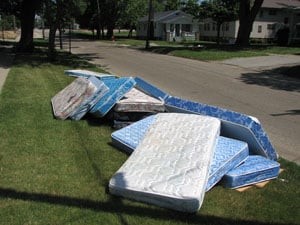We all love buying fabulous items on online marketplaces such as Craigslist, Facebook marketplace, and thrift stores. You can find some fantastic secondhand items at pocket-friendly prices in such places. The terrifying fact is that those secondhand items could have bed bugs.
Bed bugs often get into a home by hitchhiking on used and discarded items such as furniture and clothing. This, however, does not mean that you should boycott all secondhand items. This post walks you through everything you need to avoid getting bed bugs from secondhand items.
Table of Contents
Can you get bed bugs from secondhand items?
You can get bed bugs from secondhand items. I want you to picture a scenario where a friend wishes to furnish an apartment but doesn’t have adequate funds. If he buys furniture or wall curtains from craigslist, could they have bed bugs? It’s likelier that the seller disposes of those items because of a bed bug problem. Bed bug statistics show that bed bugs are in all 50 States.
People often get rid of their furniture and other belongings when they discover a bed bug infestation. Sometimes, they don’t realize that they have bed bugs when they donate their belongings to a thrift store. Either way, the risk of getting bed bugs from secondhand items is higher than from new ones. A Vice article, while quoting Jeff White, a director at bed bug central, suggests that one of the most common ways bed bugs get into homes is through used furniture.
Is using secondhand items worth the risk?
Bed bug bites can cause fatal allergic reactions. A study also suggests that bed bugs can cause dire psychological issues such as anxiety, PTSD, and suicidal tendencies. To treat bed bugs and avoid such dire consequences, you’ll have to spend between $500 and $ 1500. In a perfect world, using secondhand items is not worth the risk, especially considering the cost of treating bed bugs.
We don’t live in a perfect world, which is why it is understandable if you choose secondhand items. Used items are:
- Cheap: Buying used items is pocket-friendly, and in the post-Covid economy, we all want to settle for what is affordable. With just about $ 70, you can buy clothes, a carpet, and something for your pet. Putting the thought of bed bugs aside, that is a great deal!
- Hidden treasures: Let’s assume a family is moving away and cannot afford to bring everything along. In such a scenario, the family may decide to donate perfect furniture to a thrift store. You can buy that dream furniture within your budget with patience and a keen eye.
- Environmental Protection: Using used items allows you to recycle and play your role in sustainable living. We can not fault you for caring about your environment, especially in today’s world.
CAUTION! There are many reasons to settle for secondhand items, but you must keep an open eye for signs of bed bugs.
Inspecting secondhand items for signs of bed bugs
Bed bugs are excellent hitchhikers meaning you can bring them home on an infested secondhand item. The first step of inspecting used items is to know what bed bugs look like and all the signs of an infestation. Once you know that, you can proceed to examine your items by following these tips:
Turn clothes inside out
Bed bugs are survivors and good at hiding. Even if the secondhand items you are interested in have been treated, they will likely have found a way to survive. It is best to turn clothes inside out and inspect every nook and cranny, including seams, pockets, and linings. Some of the signs you need to look for include the following:
- Dark or rusty spots
- Blood stains
- Bed bug exoskeletons
- Bed bug eggs
Shake sheets and towels
Bed bugs are drawn to linens and towels because their folds and lining provide perfect hiding spots. Apart from thorough inspection, you must shake all used sheets and towels to ensure that there are no lingering bed bugs. A vigorous shake will ensure that any lingering bed bugs drop out.
Thoroughly check seams and edges.
Bed bugs like tight, dark, warm, and hard-to-reach spaces. Whether you take home a used couch, bed, clothing, or any other item, you must pay special attention to seams and edges. Run your fingers along tight spaces you can inspect with your eyes. These include cushion undersides, zipper linings, and decorative trimmings.
Inspect frames, springs, and undersides
Most people perform surface inspections when checking for signs of bed bugs, and that is a huge mistake. A wise individual will inspect everything, including frames, springs, and undersides. If the infestation is advanced, you will only find signs of bed bugs on the surface.
If you inspect a secondhand bed, break it down to the frame. Bed bugs can crawl on any surface upside down if they have something to clasp on. Beds are hotspots for bed bugs, so you must pry open the headboard and inspect it thoroughly. It is essential to pay attention to each component. Bed bugs can be hiding in the spaces that you least expect them.
Use a UV flashlight in your inspection.
Bed bugs shade exoskeletons as they grow through different life cycle stages. These exoskeletons emit a blue light when subjected to UV rays. Spotting signs of bed bugs is challenging, but a good UV flashlight makes your task easy.
Open and inspect drawers.
Drawers are a perfect hiding spot for bed bugs, but most of us ignore them when doing an inspection. While inspecting drawers, check all cracks and crevices inside and outside them. The drawer’s insides are dark, undisturbed, and warm, making them ideal for bed bugs. Opening drawers in any secondhand furniture is best, and inspect them thoroughly.
Secondhand items most prone to bed bugs
You may know that secondhand mattresses likely have bed bugs, but you may need to learn that many other items have similar risks. Here are some everyday secondhand items that are prone to bed bugs:
Mattresses and beds
Bed bugs feed on human blood and habitually stay near their food source. Beds and mattresses are bed bugs’ favorite spots considering most of us spend almost 8 hours sleeping daily.
Used mattresses and beds are most likely filled with bed bugs hiding in dark places such as stitches and frames. If you have to buy a used mattress and bed, you must treat the bed and use a plastic mattress encasement.
Artwork
Paintings, framed photographs, and pieces of artwork are bed bug hotspots. Bed bugs can fit in tiny gaps the size of a credit card’s thickness. They can easily crawl and hide underneath frames. It would be best if you inspected any secondhand piece of artwork.
You must take any secondhand picture out of its frame and inspect it thoroughly before taking it home. It is not advisable to check just the visible parts. Instead, pay attention to any cracks and crevices on the frame.
Bedside lamps
Secondhand bedside lamps are also notorious for bringing bed bugs into your home. Bed bugs don’t confine themselves to the bed and mattress when someone has an infestation. Since bed lamps are also close to the host during the bed bugs’ preferred feeding time, they are ideal hiding spots. Fabric lampshades are riskier than ordinary ones because bed bugs can crawl inside their seams and find perfect hiding spots. Before taking it home, check every part of the secondhand lamp, including its cord, inside screw holes, and base.
Avoiding bed bugs from secondhand items
I am sure you don’t wish to be one of those people with a huge bed bug problem on their hands. You can take several measures to avoid getting bed bugs from secondhand items. They include:
- Ask a lot of questions concerning the origin of the secondhand item. Don’t take it home if the answers are not satisfactory.
- Inspect all secondhand items for signs of bed bugs. If you see any worrying signs, do not buy the item. Even if you don’t see any signs, treat all secondhand items anyway.
- Store all secondhand items in sealed plastic bags and wash and dry them in extremely high temperatures. After the wash, putting in a few puffs of essential oils will also help against bed bugs.
- Avoid buying any secondhand item that is upholstered or does not have a removable cover.
- Avoid putting secondhand items near your bed for a while, even after inspection and treatment.
Final Thoughts
Using secondhand items is, without a doubt, a risky business. You must way the risks of bringing secondhand items into your home against the rewards. If it is an item that you can’t do without and cannot afford to buy a new one, you must observe all necessary precautions. As outlined in this post, some of them include:
- Always inspect secondhand items
- Ask lots of questions about the origin of secondhand items
- Avoid things that are hard to inspect and treat, such as upholstered furniture
FAQs
How long can bed bugs live in secondhand items?
Bed bugs can survive for up to one year on second-hand items without feeding, provided conditions such as warmth and humidity are ideal.
Can bed bugs live in secondhand furniture?
Bed bugs can live on all secondhand items, including furniture because they can live for a while without feeding. Bedroom furniture is likelier to have bed bugs than other pieces of furniture.
Can you find bed bugs in secondhand books?
Yes, you can find bed bugs in secondhand books. A book’s spine and binding provide perfect hiding spots for bed bugs.


